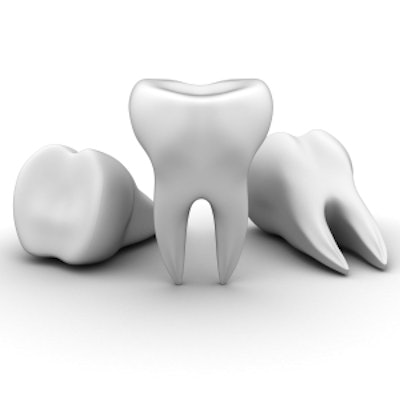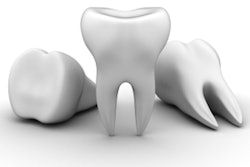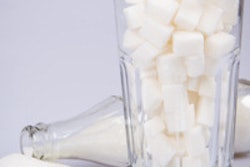
If enamel erosion could be accurately measured, preventive measures could be taken to preserve tooth enamel. However, there are no in vivo diagnostic tests to measure erosion activity.
To address this need, researchers from the U.K. wanted to find out if roughness data from one central location on a tooth was representative of that tooth's overall surfaces before and after erosion. While they initially thought they would need a larger surface area to measure erosion, they found that the data from one central location does suffice, which may offer a way to measure erosion and help patients maintain the health of their enamel.
"For both unpolished and polished enamel, there were no significant differences measuring the central cluster or the four peripheral clusters before or after erosion," the authors wrote (PLOS One, August 3, 2017).
The study was led by Francesca Mullan, BDS, a doctoral student at the King's College London Dental Institute at Guy's, King's and St.Thomas' Hospitals in London.
Uneven surface
Early detection and diagnosis of dental erosion are important for maintenance of dental enamel, but there are no in vivo diagnostic tests that can measure this activity. The researchers speculated that a possible predictor of early erosion might be changes to enamel's surface roughness, which means there is a need to find out if noninvasive, high-quality measurements have the potential to be applied clinically.
Precisely mapping unpolished enamel is difficult because of its curved and textured surface. So rather than focus on the real surface of enamel, most previous studies have substituted polished and flattened enamel surfaces, which has limited use in real-practice situations, according to the authors.
The researchers of the current study wanted to find out if roughness data from one central location of unpolished and polished enamel were representative of the overall surface before and after erosion. They initially thought that nonuniform surface roughness would discount this approach.
“For both unpolished and polished enamel, there were no significant differences measuring the central cluster or the four peripheral clusters before or after erosion.”
For their study, the researchers embedded 20 human enamel sections (4 x 4 mm) in bisacryl composite and randomized them to either a native or polishing enamel preparation protocol. They subjected the enamel samples to a 15-minute acid challenge of orange juice for three cycles. They had measured median surface roughness at baseline and then after erosion from both a centralized cluster and four peripheral clusters on each section. Within each cluster, five smaller areas provided the roughness data.
To their surprise, the researchers found no significant differences between measuring one central cluster or four peripheral clusters for both the unpolished and the polished enamel samples before and after erosion.
For unpolished enamel, the single central cluster had a median surface roughness of 1.45 µm, and the four peripheral clusters had a median of 1.32 µm before erosion. After erosion, the researchers found statistically significant reductions to 0.38 µm and 0.34 µm, respectively (p < 0.0001).
Polished enamel had a median surface roughness 0.04 µm for the single central cluster and 0.05 µm for the four peripheral clusters. After erosion, the value increased to 0.27 µm for both (p < 0.0001), a statistically significant increase, according to the authors.
"Measuring one central cluster of unpolished and polished enamel samples to determine surface roughness is sufficient for subsequent studies," they wrote. "Polished enamel becomes significantly rougher after erosion, and unpolished enamel becomes significantly smoother after erosion. These observations suggest that surface roughness derived from optical profilometry at a relatively low lateral resolution, utilizing replica methodologies, may be a relevant in vivo measure of enamel erosion."
Central cluster
As for study limitations, the authors noted that the extracted molars used may have had previous fluoride exposure. However, it is likely that after 45 minutes of cyclical erosive challenges, any benefits the unpolished enamel samples may have had from any fluoride exposure would have been overridden, they wrote.
The study findings show that a central cluster can be used for roughness measures and, while polished enamel becomes significantly rougher, unpolished enamel becomes significantly smoother following exposure to dietary acid erosion, the authors concluded.
"Measuring one central cluster of unpolished and polished enamel was representative of the overall enamel surface roughness, before and after erosion," they wrote.
Study disclosure
The study was funded by GSK Consumer Healthcare of Weybridge, U.K.



















